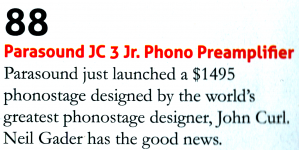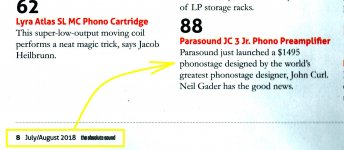What I was drawn to about Damir's design was the results I found when testing it. With only moderate over-all NFB the thd with 4 Ohm load and 20Khz is .001x % at 350W. measured.
The distortion does not change much with power or freq or load. Now that is something new. It is also quiet and fast (high slew rate).
🙂 <3
I hope all DIY'ers get to build it and hear it or its variations by Damir in their own homes. He has been very generous with his design here at DIYAudio. If we are lucky, he also might sell a bunch of them and get compensated. But, the way I built it, it will be expensive. Sorry, Waly.
THx-RNMarsh
The distortion does not change much with power or freq or load. Now that is something new. It is also quiet and fast (high slew rate).
🙂 <3
I hope all DIY'ers get to build it and hear it or its variations by Damir in their own homes. He has been very generous with his design here at DIYAudio. If we are lucky, he also might sell a bunch of them and get compensated. But, the way I built it, it will be expensive. Sorry, Waly.
THx-RNMarsh
Last edited:
The amp made in Thailand has more than 60 dB of GNFB from zero up to 20 kHz.
What I was drawn to about Damir's design was the results I found when testing it. With only moderate over-all NFB the thd with 4 Ohm load and 20Khz is .001x % at 350W. measured.
This is clearly a different definition of 'moderate' that the one I use. As Self quotes around 35dB as being all you need 60dB would seem in the high category?
<20-30dB is low, 100+ is high. And what dB's is a two opamp composite ?😱
THx-RNMarsh
THx-RNMarsh
Last edited:
That sounds like an awesome amplifier. What's the make and model number on it?
-Chris
Model A700 UHR. Brand is MARSH. Reg in Asia for many years. Manufactured by MagnetAudio in Bangkok suburbs, Thailand. Waiting on more funding a.t.t. They are expensive to build, so I only put up enough cash for 3 samples. One for me, one for Damir and one for principal EE at MagnetAudio.
Get in line. 🙂
-RM
Last edited:
<20-30dB is low, 100+ is high. And what dB's is a two opamp composite ?😱
THx-RNMarsh
When you're nominally dealing with -40 dB/decade in a composite, probably best to talk about at what frequency. 😉
100 dB of feedback at 20 kHz? I haven't run the numbers but that's going to need one heck of a fast set of opamps to have the GBW, even with higher order compensation networks in place. That's a fun project in maintaining stability. JCX got going with some of his headphone designs using tpa6120, if I'm remembering my history right. Can't remember his "servo" opamp.
In many old Knob & Tube homes, the Hot and Neutral wires did not have a one-to-one relationship. An electrician wiring an outlet would connect to any handy nearby Neutral wire. Then they had to solder and tape all the wire to wire junctions (open air, not in boxes) and the soldering irons were not electric powered.
Last edited:
My first neighbor's home was built by Wentworth of Boston's Wentworth Ins. in 1888, he said the first home wired in Cambridge the wires were in channels milled out of the baseboards. He tried to get them to let him leave it for historical reasons.
Chris, Just behind me.
100db/1 watt/4 ohms is about 125 db allowing for some dynamic thermal compression - just what I need in the shop. Oh forgot to add 3 or 4 db for 4 speakers. Next falls diy meet we can all stand outside
100db/1 watt/4 ohms is about 125 db allowing for some dynamic thermal compression - just what I need in the shop. Oh forgot to add 3 or 4 db for 4 speakers. Next falls diy meet we can all stand outside
Oops, yer right. The Absolute Sound (not Stereophile!), July/August 2018, Issue 284. Sorry for the error.
_
_
Attachments
Last edited:
<20-30dB is low, 100+ is high. And what dB's is a two opamp composite ?😱
THx-RNMarsh
I would argue by audio standards 6dB is low 20-35 is normal anything over 50 is high but we are close enough to agreement.
Had a furtle and found the published loop gains. 225dB at DC, 100dB at 1kHz and 49dB at 20kHz .
Some old tests with back to back isolation transformers (non shielded).
The “Live Probe” schematic is from a “Wireless World” article (sorry, I can’t find year/volume number/author)
George
That is a good way to measure what's getting out of the equipment, what's getting in you can directly measure on the secondary side of the transformer.
I use a tiny inductive pick up. calibrated. But relative numbers are OK for this purpose.... make your own.
A tiny video recording/playback head works well. Get a used/broken video VHS machine and take the head out and use it into wide band amp, scope, sensitive VM etc. Moving the head in close proxy to a wire will pick up the signal in that wire.
-RNM
A tiny video recording/playback head works well. Get a used/broken video VHS machine and take the head out and use it into wide band amp, scope, sensitive VM etc. Moving the head in close proxy to a wire will pick up the signal in that wire.
-RNM
Last edited:
- Status
- Not open for further replies.
- Home
- Member Areas
- The Lounge
- John Curl's Blowtorch preamplifier part III

